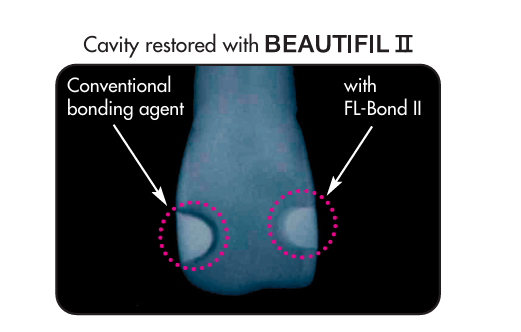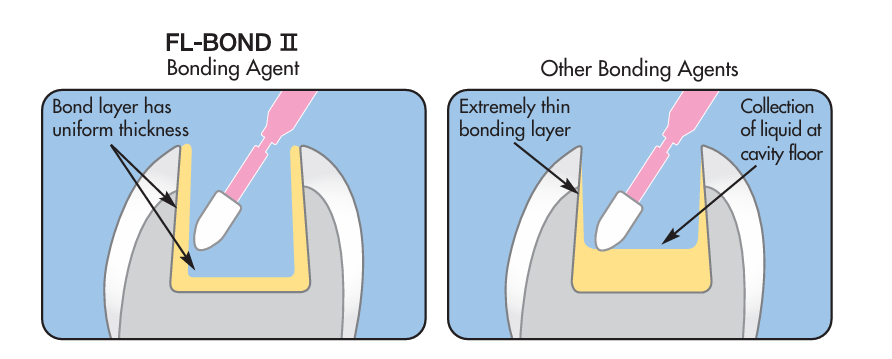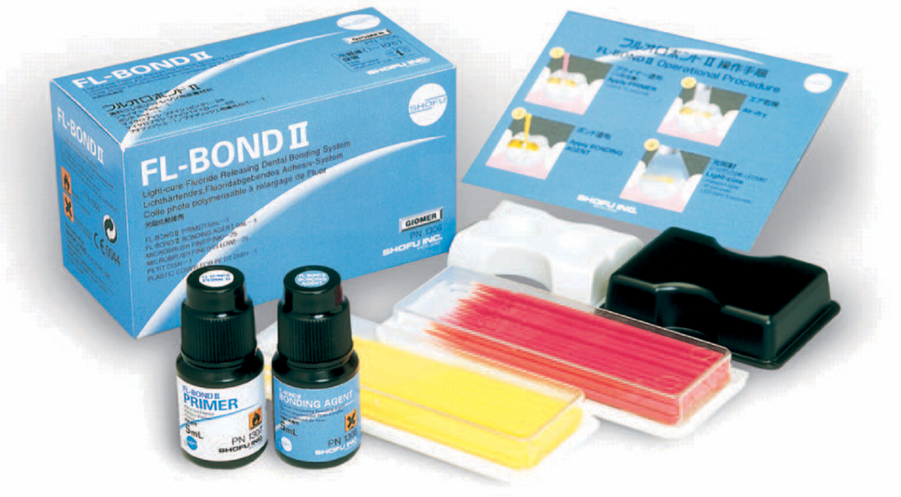About the product
Get to know Shofu FL Bond II Bonding System ®
Product Description:
- FL-Bond II is a two-step self-etching adhesive system.
- Features Giomer bioactive technology.
- Releases fluoride, sodium, aluminum, borate, strontium, and silicate ions.
- Effective in decreasing postoperative sensitivity.
- microleakage at restoration margins (particularly in Class V and II cavities).

Product Characteristics:
- The hydrophilic acidic primer does not contain acetone or HEMA.
- no odor, leading to less postoperative sensitivity.
- The acid primer contains two special monomers:
- Phosphonic acid (6-MHPA): penetrates between collagen fibers and chemically adheres to calcium.
- Carboxylic acid (4-META): penetrates between the collagen fibers and chemically adheres to collagen.
- Uses ethanol as a solvent.
- Does not contain MDP.
- HEMA-free primer prevents hydrolysis-induced bond interface deterioration, ensuring longer-term bond durability.
- The bond has excellent viscosity.
- uniform application with a film thickness of approximately 20 μm.
- Adapts well to preparation walls.
- Approximately 40% of the adhesive consists of fluoride-releasing filler particles.
- Relies on S-PRG (Surface Pre-Reacted Glass-ionomer) particle technology.
- Offers greater protection against microbial invasion via microleakage.
- Forms an acid-resistant layer both inside and under the resin-reinforced dentin complex (the hybrid layer).
- Continuous fluoride release has a cariostatic effect.
- Stimulates remineralization of areas prone to secondary caries.
- Forms a radiopaque halo for effective radiographic follow-up.
- fluorescence; UV light use during adhesive removal enhances visualization.

Indications for Use:
- Promotes bonding of any composite to enamel and dentin.
- Suitable for Class I to V restorations.
- Suitable for non-carious lesions (abfraction, etc.).
- For deep restorations.
- Restoration of exposed and hypersensitive root surfaces.
- Intraoral repair of fractured indirect restorations (when used with Metal Link Primer).


Application Protocol:
- The self-etching primer prepares dentin and enamel surfaces.
- Modifies the smear layer while eliminating the need for a pre-etching step.
- Two simple steps take just 35 seconds.
- Treated area immediately receives restorative materials.
Application Steps:
- Stage 1 (Priming):
- Dispense primer and carefully apply to enamel and dentin surfaces for 5 seconds.
- Let it rest for 10 seconds.
- Dry with a jet of air for 5 seconds (do not rinse).
- Stage 2 (Bonding):
- Dispense the adhesive agent and carefully apply a homogeneous layer (no air jet).
- Light cure for 10 seconds with a halogen light or 5 seconds with an LED light.
Packaging
- Available with 5 ml of primer and 5 ml of bond.
- Includes 25 red microbrushes, 25 yellow microbrushes, and two cocoons.
Additional Features
- The FL-BOND II PRIMER contains a new effective adhesion promoting monomer and is acetone free with no incorporation of HEMA to minimize odor and post operative sensitivity.
- The FL-BOND II BONDING AGENT contains the S-PRG filler (Surface Pre-Reacted Glass-ionomer), which helps to reinforce the bonding interface between the restorative material and the tooth structure.
FL-Bond II Kit Contents and Product Benefits
- The images present a two-step, self-etching fluoride releasing dental bonding system.
- Kit Contains: Bonding agent 5ml, primer 5ml, 25 red microbrushes, 25 yellow microbrushes and dish
Radiopacity for Accurate Diagnosis
- Highlighting, Radiopacity for accurate diagnosis.
- Shows cavity restored with BEAUTIFIL II vs. Conventional bonding agent with FL-Bond II.
BONDING AGENT and Enamel & Dentin Priming steps
- Dispense the Primer and apply thoroughly on the enamel and dentin surfaces.
- Dispense the Bonding Agent and apply an even layer on the entire surface.
Chart showing results
- Graph Chart: Initial Bond Strength vs. Bonding Durability after 2,000 Thermal Cycles.
- The graph demonstrate both Enamel and Dentin, FL-BOND II.
Anti-Bacterial Effect for Added Protection
- Illustrates how FL-BOND II forms an acid resistant layer in and beneath the complex of resin-reinforced dentin (hybrid layer) due to the continuous release of cariostatic fluoride that stimulates the remineralization of areas prone to secondary caries.
Video about the product
Brand or manufacturer
Meet Qasr Al-Tibb Medical Partners

SHOFU Medical Company
Shofu Inc., established on May 15, 1922, in Kyoto, Japan, by Kajo Shofu III, is a leading manufacturer of dental materials and equipment. Originally focusing on high-quality porcelain denture teeth, the company has expanded its product range over the decades to include abrasives, restorative materials, dental cements, ceramics, CAD/CAM systems, orthodontic devices, and preventive solutions.
Shofu's commitment to innovation and excellence has led to its global presence, with subsidiaries in the USA, Germany, the UK, Singapore, and China. In 1989, it became the first dental company to be listed on the national stock exchange in Japan and was subsequently listed on the Tokyo Stock Exchange.
The company is publicly traded under the ticker symbol TYO:7979.
Throughout its history, Shofu has maintained close ties with the global dental community, collaborating with universities and research institutions to stay abreast of evolving trends and techniques in dentistry. This dedication to research and technological innovation ensures that Shofu continues to provide products that meet the highest standards of quality and safety.
Headquartered in Kyoto, Japan, Shofu remains committed to its mission of contributing to dentistry through innovative business activities, aiming to help people worldwide achieve health and attractive smiles.
Frequently asked questions (FAQ)
Answers to your questions and inquiries about the product
What is Giomer technology, and what are its benefits in FL-Bond II?
Giomer technology is a bioactive glass filler that releases fluoride and other ions (sodium, aluminum, borate, strontium, and silicate). This release helps to decrease postoperative sensitivity, prevent microleakage, and promote remineralization of the tooth structure.
What are the advantages of using a HEMA-free primer?
The HEMA-free primer reduces the risk of postoperative sensitivity, minimizes odor, and enhances the long-term durability of the bond by preventing hydrolysis.
Is a separate acid-etching step required before using FL-Bond II?
No, FL-Bond II is a self-etching adhesive system, so a separate acid-etching step is not necessary. The self-etching primer prepares the enamel and dentin surfaces.
What is the recommended application time for FL-Bond II?
The total application time for FL-Bond II is just 35 seconds, making it a quick and efficient bonding solution.
How should I apply the primer and bonding agent?
Dispense the primer and apply it thoroughly to the enamel and dentin surfaces for 5 seconds. Let it rest for 10 seconds, then dry with a gentle stream of air for 5 seconds. Next, dispense the bonding agent and apply a thin, even layer to the prepared tooth surface.
What is the recommended light-curing time for FL-Bond II?
Light-cure the bonding agent for 10 seconds using a halogen light or 5 seconds using an LED light.
What is the role of the S-PRG filler in FL-Bond II Bonding Agent?
FL-Bond II is indicated for promoting bonding of any composite to enamel and dentin in Class I to V restorations, including non-carious lesions, deep restorations, and restoration of exposed or hypersensitive root surfaces. It is also suitable for intraoral repair of fractured indirect restorations when used with Metal Link Primer.
What are the steps for application?
The unique S-PRG filler (Surface Pre-Reacted Glass-ionomer) in the bonding agent has an ideal viscosity to ensure uniform application with optimal polymerization on the marginal area and cavity walls to provide a secure marginal seal. Also it gives anti-bacterial for added protection.
Does FL-Bond II contain MDP?
No, the document states that it does not contain MDP.
What does it mean that FL-Bond II has fluorescence?
The fluorescence property means that if a dentist uses a pen with UV light when removing the adhesive, he/she will have better visualization and, therefore, will be better able to preserve the tooth structure.



